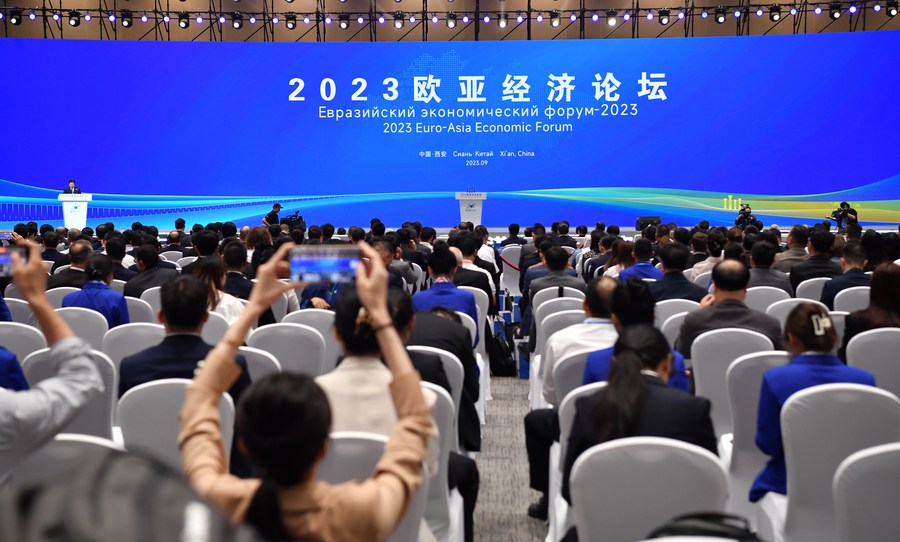
This photo taken on Sept. 22, 2023 shows a scene at the 2023 Euro-Asia Economic Forum in Xi'an, capital of northwest China's Shaanxi Province. The 2023 Euro-Asia Economic Forum (EAEF), with the theme of creating opportunities for cooperation and pursuing future development, opened on Friday in Xi'an, the capital of northwest China's Shaanxi Province. (Xinhua/Shao Rui)
XI'AN, Sept. 25 -- Employing his fluent Chinese, Wouters Jeffery was busy introducing his Belgian products to expo visitors, pouring beer for them to taste.
Held on the sidelines of 2023 Euro-Asia Economic Forum, the economic and trade expo was held from Friday to Monday in Xi'an, the capital of northwest China's Shaanxi Province.
Stationed in Xi'an, Jeffery, 35, works for a Brussels-based import consulting services company. The total trade value of his company exceeded 4 million yuan (about 557,670 U.S. dollars) in 2019, importing food, software and other products for multiple clients from Europe.
"The pandemic seriously affected our business over the past three years. We expect the business will pick up this year," said Jeffery, adding that more companies have turned to them this year as potential future clients.

A visitor learns about imported beer during EAEF Economic and Trade Cooperation Expo & China (Shaanxi) Import & Export Commodities Exhibition in Xi'an, capital of northwest China's Shaanxi Province, Sept. 22, 2023. (Xinhua/Shao Rui)
This year marks the 10th anniversary of the Belt and Road Initiative (BRI).
Over the years, the BRI has brought closer trade and cultural ties in the Euro-Asian region, with people from BRI countries benefiting from trade exchanges, communications and cultural integration.
In the theme exhibition area featuring five Central Asian countries, exhibitor Zhao Xiliang treated visitors to purple candies from Uzbekistan made from cocoa butter.
"If there were no BRI, the agricultural products from the farmland in Central Asia would be difficult to bring to the dining tables of Chinese consumers," said Zhao, adding that more and more Chinese enterprises are participating in trade with Euro-Asian countries, helping with local industrial upgrading and product optimization.
Statistics show that from 2013 to 2022, China's trade in goods with Belt and Road countries increased from 1.04 trillion U.S. dollars to 2.07 trillion U.S. dollars, while two-way investment exceeded 270 billion U.S. dollars.
According to a World Bank research report, by 2030, the BRI will increase trade among participating countries by 2.8 percent to 9.7 percent, global trade by 1.7 percent to 6.2 percent, and global income by 0.7 percent to 2.9 percent.

People visit the EAEF Economic and Trade Cooperation Expo & China (Shaanxi) Import & Export Commodities Exhibition in Xi'an, capital of northwest China's Shaanxi Province, Sept. 22, 2023. (Xinhua/Shao Rui)
Adil Ahmed, a dealer in artwork decorations from Pakistan, has been attending expos and fairs of various kinds in China almost every year for the past 17 years.
"When first I came to China, I could barely find a local speaking English," he said. "Things began to change after the 2008 Beijing Olympics, when I started to find more and more English speakers in China."
The 65-year-old has traveled to many countries for business, including Canada, Japan and Vietnam, but he does the best business in China.
"For one thing, the large population in China means a large market. For another, I have more fairs held in different Chinese cities to attend," he said, adding that his next stop is the city of Qingyang, Gansu Province, where a trade fair is scheduled to start soon.
The Asian culture shared by Chinese and Pakistani people is another reason his business is booming in China, he noted.
Such an opinion is shared by Suresh Pariyar, a Nepalese man selling singing bowls. The singing bowl is a kind of tool for sound therapy, which is usually used in massage rooms and yoga gyms to calm the nerves.
The 36-year-old said the therapy is part of Nepalese culture, and it is also popular in other Himalayan regions, including China's Tibet. His exhibits are favored by more and more Chinese people.
"I'm glad that I can spread the culture of my home country here," he said.
Having been living in Xi'an for 12 years, Jeffery is married to a Chinese woman and has a five-year-old child.
He said the BRI has helped more Westerners learn more about China and Chinese culture.
"My mother in Belgium has fallen in love with green tea. Instead of tea bags, she now prefers tea leaves," he said with a smile.












